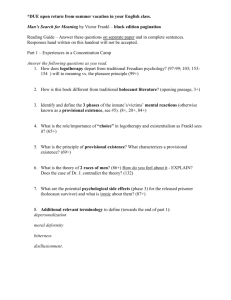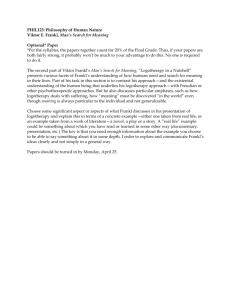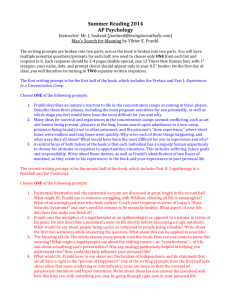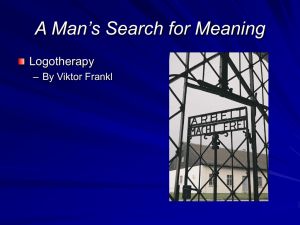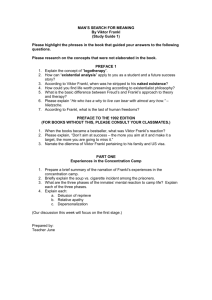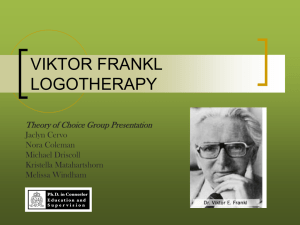Logotherapy – Theoretical Aspects and Field Studies in Israel
advertisement
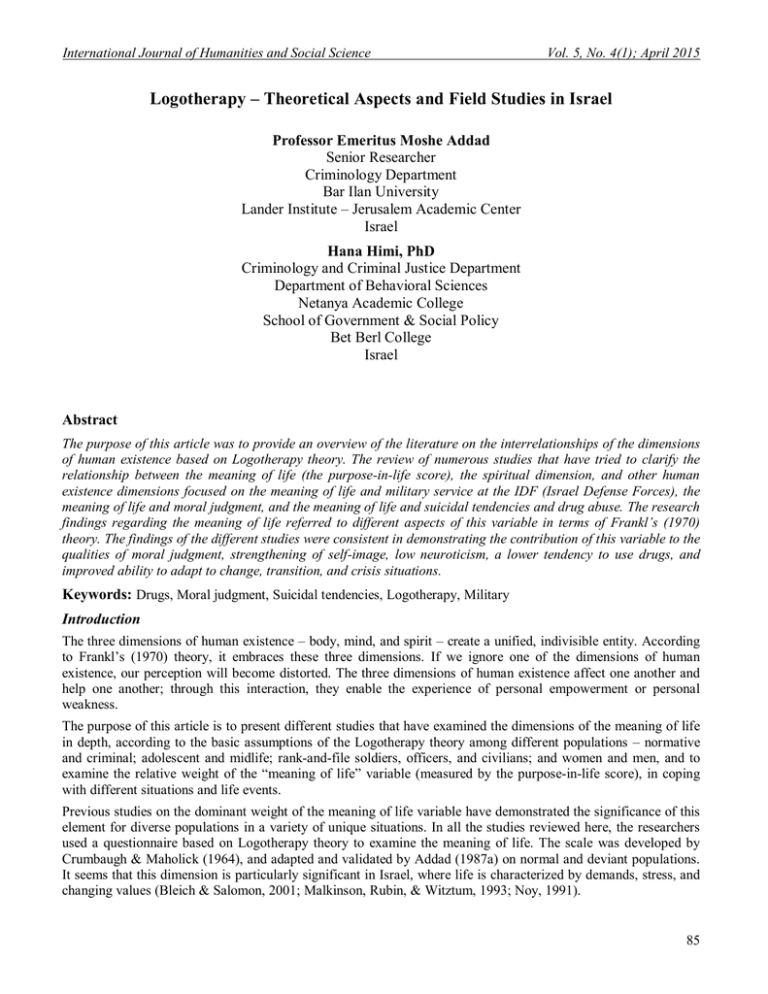
International Journal of Humanities and Social Science Vol. 5, No. 4(1); April 2015 Logotherapy – Theoretical Aspects and Field Studies in Israel Professor Emeritus Moshe Addad Senior Researcher Criminology Department Bar Ilan University Lander Institute – Jerusalem Academic Center Israel Hana Himi, PhD Criminology and Criminal Justice Department Department of Behavioral Sciences Netanya Academic College School of Government & Social Policy Bet Berl College Israel Abstract The purpose of this article was to provide an overview of the literature on the interrelationships of the dimensions of human existence based on Logotherapy theory. The review of numerous studies that have tried to clarify the relationship between the meaning of life (the purpose-in-life score), the spiritual dimension, and other human existence dimensions focused on the meaning of life and military service at the IDF (Israel Defense Forces), the meaning of life and moral judgment, and the meaning of life and suicidal tendencies and drug abuse. The research findings regarding the meaning of life referred to different aspects of this variable in terms of Frankl’s (1970) theory. The findings of the different studies were consistent in demonstrating the contribution of this variable to the qualities of moral judgment, strengthening of self-image, low neuroticism, a lower tendency to use drugs, and improved ability to adapt to change, transition, and crisis situations. Keywords: Drugs, Moral judgment, Suicidal tendencies, Logotherapy, Military Introduction The three dimensions of human existence – body, mind, and spirit – create a unified, indivisible entity. According to Frankl’s (1970) theory, it embraces these three dimensions. If we ignore one of the dimensions of human existence, our perception will become distorted. The three dimensions of human existence affect one another and help one another; through this interaction, they enable the experience of personal empowerment or personal weakness. The purpose of this article is to present different studies that have examined the dimensions of the meaning of life in depth, according to the basic assumptions of the Logotherapy theory among different populations – normative and criminal; adolescent and midlife; rank-and-file soldiers, officers, and civilians; and women and men, and to examine the relative weight of the “meaning of life” variable (measured by the purpose-in-life score), in coping with different situations and life events. Previous studies on the dominant weight of the meaning of life variable have demonstrated the significance of this element for diverse populations in a variety of unique situations. In all the studies reviewed here, the researchers used a questionnaire based on Logotherapy theory to examine the meaning of life. The scale was developed by Crumbaugh & Maholick (1964), and adapted and validated by Addad (1987a) on normal and deviant populations. It seems that this dimension is particularly significant in Israel, where life is characterized by demands, stress, and changing values (Bleich & Salomon, 2001; Malkinson, Rubin, & Witztum, 1993; Noy, 1991). 85 ISSN 2220-8488 (Print), 2221-0989 (Online) ©Center for Promoting Ideas, USA www.ijhssnet.com Frankl (1970) referred to the human spirit as the noetic dimension. The term is derived from the Greek noos, meaning “wisdom.” Frankl included all spiritual aspects in this term, so that the noetic dimension includes different traits, such as longing for meaning, goal setting, ideas, creativity, imagination, faith, love that is beyond the physical dimension, morality, spiritual elevation, commitment, a sense of humor, and freedom of choice. This spiritual dimension may provide the individual with functional autonomy – the freedom to act responsibly and out of free choice.. The ability of individuals to cope with different changes and demands encountered in daily life depends, among other things, on their personality traits. Coping and adjustment are affected by the complexity of interaction among personality variables and environmental variables. Different studies on this subject have employed Eysenck’s (1967, 1985) theory, which defines personality variables and the interaction of different elements in the environment with personal needs and preferences. According to Eysenck, neuroticism is represented by a continuum of emotional stability, with individuals who are very stable at one end and individuals who are unstable at the other end. Maintaining emotional instability is related to the meaning of life; a high level of neuroticism erodes one’s ability to employ cognitive and emotional qualities in order to cope with the myriad of demands placed on the individual, thus gradually impairing the perception of the meaning of life. As different approaches in psychotherapy developed, professionals in the practice and research alike acknowledged the meaning of life as a dominant variable in the individual’s mental health and quality of life (Frankl 1959, 1967; Maslow, 1971; Yalom, 1980). Yalom (1980) discussed the meaning of life from the existential aspect. His approach focused on coping with the four existential conflicts that every individual has to face: death, freedom, isolation, and the lack of meaning. He perceived the meaning of life as the individual’s creative response to the lack of the world’s total meaning. Meaning cannot be created outside people since they have to create it themselves. According to Yalom (1980), the meaning of life can be created in a number of ways: through altruism, devotion to goals, creativity, or hedonism. He argued that people should be fully committed to their own “unique” meaning if they want to avoid anxiety that could develop due to lack of meaning. According to this approach, life without meaning, goals, values, or ideals could lead to different levels of distress in each individual. In his Logotherapy theory, Frankl (1967, 1970) presented unique qualities, contents, and implications of the meaning of life. The theory is based on the assumption that a human is an entity composed of three dimensions: body, mind, and spirit. It is complex, comprised of features that are unique to humans: existential meaning, freedom of choice, conscience, moral commitment, nonphysical love, goal setting, ideas, imagination, creativity, a sense of humor, and faith. Fabry (1983) noted the lack of a clear distinction between the mental and spiritual dimensions. According to his perspective, meaning lies within the individual’s motive for spiritual actions, the basis for implementing decisions in order to rise above the boundaries of the self. In contrast, actions of the mental dimension are taken in order to realize emotional needs. The meaning of life is the individual’s state of mind; therefore, it lacks a uniform definition. The meaning of life is different for each person; it is not something general, but rather unique to the given person at a specific moment. The findings of the research reviewed here regarding the dominant relative weight of the meaning-of-life score among different populations support this view of the meaning of life as an individual state, unique to each individual at a given moment. A person’s actions and patterns for coping with a changing reality express that individual’s interpretation of the meaning of life and views. People’s behavior, aspirations, and habits are subject to the meaning that they attribute to their respective lives. According to the basic assumptions of Frankl’s model, it seems that positive relatedness based upon facing challenges and coping with changes and life events, which may be stressful and demanding, may promote adjustment to different types of situations. In the following we review the findings of different studies of the interaction among all or any of these three variables and the meaning of life. 86 International Journal of Humanities and Social Science Vol. 5, No. 4(1); April 2015 The Meaning of Life and Military Service in the Israel Defense Forces A number of studies have been devoted to in-depth investigation of the relationship between the meaning of life and adjustment to the military environment, including the initial training stage (Katz, 1997) coping with military service in training and in imprisonment units (Himi, 1989), and the process of retirement and separation from military settings (Himi, 2000). Himi (2000) studied the adjustment of military personnel to retirement from the Israel Defense Forces (IDF) (N = 335) at midlife with respect to the myriad of changes experienced by retirees in all aspects of life – the intrapsychological, the familial, social, and professional. Goffman (1968) examined the resources employed in the process of adjusting to the changes that accompany retirement and detachment from a total institution (Goffman, 1968). The experience of midlife retirement combines basic elements emphasized in Adler’s approach (1969): awareness, striving for perfection and superiority, the social factor, and freedom of choice. According to this approach, individuals are born with a sense of inferiority and strive throughout their lives to gain superiority, independence, freedom and self-actualization. One of Adler’s (1969) basic assumptions is that the human is a social being by nature and is motivated by a social drive; people are not only the product of genetics and environment, but respond to the environment in expressions of creativity and action. Furthermore, people differ in what Adler calls “lifestyle,” which is based upon the unique interpretation that individuals attribute to their inferiority. In other words, this approach emphasizes the meaning that individuals attribute to their experiences in reality. Accordingly, retirees must organize both emotionally and cognitively for a given situation, while considering their broader social environment as well as their immediate family environment. The kind of lifestyle manifested in the individual’s behavior (either active or passive) and emotions become clearer in light of the changes involved in retirement, especially in cases of retirement from a total institution. The ability to handle the changes that accompany retirement from military service depends, among other factors, on the individual’s personality traits as expressed in a “preparation ground.” According to Addad (1987, 1988), the preparation ground is the entirety of an individual’s experiences, such as love, security, trust, and satisfaction, which form the foundation for coping with stressful situations in the present and future. This preparation ground serves as the person’s basis for adapting to change and coping with its implications. The retirement experience is a situation that involves change and transition from a total institution to the world outside that institution; as such, it may affect one’s personality. The wider the gaps between settings and the more areas of life (such as family, social life, and work) involved in the change, the greater the potential for a retirement crisis and the importance of personal resources, including the meaning of life. Adjustment to an event is a function of the resources available to the retiree and the way he or she perceives the event. Since coping with this experience involves interaction of personality traits and environmental demands, it can be understood in terms of Eysenck’s (1985) theory, which focuses on the meaning of the encounter between personality traits (extraversion, introversion, and neuroticism) and environmental characteristics. Frankl also examined the broader aspect of the meaning of life, which involves the individual’s basic cognitive and emotional relatedness to his or her own life. Among all groups of retirees in Himi’s (2000) study perception of the meaning of life contributed more than any other research variable (perceiving retirement, environmental resources, personality variables, personal resources, and acquired resources) to the explanation of adjustment. The research findings confirmed the hypothesis that the meaning of life (PIL) that the individuals created for themselves would constitute a primary force in empowering the self and facilitating one’s ability to overcome instability, especially during the complex process of coping with retirement, a period of considerable instability in many spheres – family, marriage, social, professional, and personal aspects of life. Thus the findings indicated that meaning of life is a basic factor that affects the state of mind and emotional resources involved in dealing with the stressful experience of retirement from military service. Lucas (1988) discussed the meaning of life and values based on the principles of Logotherapy presented by Frankl (1970). She divided people dichotomously according to their values, distinguishing between those who found security within a system of parallel values and those who found security within a system of pyramidal values. According to this approach, people with a system of parallel values are those who find security in their lives by relying on values that are equally important and equally meaningful. 87 ISSN 2220-8488 (Print), 2221-0989 (Online) ©Center for Promoting Ideas, USA www.ijhssnet.com In comparison, those with a system of pyramidal values possess one most important value, at the top of the pyramid and strive to realize this single dominant value, thereby neglecting other areas. Lucas’s (1988) research findings confirmed the hypothesis that retirees with a system of co-existing (parallel) values, as opposed to a system of hierarchical (pyramidal) values, and who found self-actualization and meaning in their work, relationship with their partners, and social ties would exhibit better adjustment to retirement. The meaning of life component (PIL) reflects the retiree’s view of the future, with emphasis on coping with existential tasks and goals as well as understanding their meaning and significance. The empowerment of the self can be achieved in different ways. Meaning of life is one possible way for the self to overcome internal pressures. Anxiety is the result of the process of suppressed emotions and empowerment of the self can potentially minimize its negative effect. Neuroticism is an external manifestation of the internal emotional state; it affects the individual’s functioning on different levels. Empowerment of the self is an important means to stabilizing the internal forces (Addad, 1987). Himi (1989, 2000) found that meaning of life was a contributing factor to the expansion and empowerment of the self. According to Frankl (1970), lifestyle does not determine a person’s condition; rather, the person’s definition of how he or she copes with the experience is what matters. The mental dimension provides the individual with autonomous functioning, that is, the freedom to act responsibly and based on personal choice. This process helps the individual cope with situations that are both challenging and stressful. The dimension of the meaning of life (PIL) includes the process of self-empowerment, which enables individuals to overcome their anxiety and find solutions to internal distress, and facilitates their handling of obstacles to adjustment. Individuals who find personal existential gain functional ability in the present and the future, as well as motivation to take action to change the conditions; at the same time, they also undergo a process of adjustment and affiliation with the group. The spiritual dimension includes the concept of human freedom, that is, the ability to act in accordance with an internal authority according to one’s chosen roles, to fulfill commitments to act, and to achieve goals. It involves carrying out actions that are meaningful to the individual in work and daily activities, as well redefining one’s views regarding work, life, and significant others. Understanding the aspects of the meaning of life helps us appreciate the contribution of this variable to better adjustment to retirement in general. Himi’s (2000) findings confirmed Frankl’s (1970) theory regarding the significance of the meaning of life to adjustment under situations of change and transition. They also revealed that the couple relationship was a significant supporting factor during the retirement process; highlighting the importance of emotional support in such situations. As noted, Himi’s (2000) findings on the adjustment of retired military professionals also corroborated Frankl’s (1970) argument that it is not conditions that determine a person’s reactions, but rather the person who determines whether to succumb to or confront stressful situations. Viewing change and life events as a challenge, despite the stress and demands involved, promotes adjustment to change in different life areas. The significance of the meaning of life variable has also been demonstrated in research on adolescent soldiers. In their study of burnout in soldiers (N = 159) serving in different units characterized by different levels of totality, Addad and Himi (1989) found that the meaning-of-life variable (PIL) significantly affected burnout. Burnout is a slow and gradual process of erosion of one’s resources, accompanied by a constant struggle to cope with both clear and obscure pressures in daily life. Although it is accompanied by symptoms, usually behavioral, allowing identification and intervention at an early stage, it is not easy to detect the process of developing burnout. According to the neo-psychophysical model of the individual (Frankl, 1970), it is affected by personality variables, the work environment, and the individual’s perception of the meaning of life. Personality traits and the perception of the meaning of life are essential resources for coping with burnout in the physical, mental, and spiritual dimensions. The main theoretical contribution of Himi’s (1989) study was its perception of the individual as a neopsychophysical unit, according to Frankl’s model (1970) and validation of this approach. The study also clarified the interaction between personality, situational variables, and the three dimensions – physical, emotional, and mental – of the burnout process. 88 International Journal of Humanities and Social Science Vol. 5, No. 4(1); April 2015 The findings regarding the relationship between burnout and mental corroborated the findings of Addad’s (1987) examination of psychogenic neurosis and neogenic solutions. According to Himi’s (1989) findings, the higher the neurosis score, the lower the meaning-of-life score was, and vice versa (the lower the neurosis score, the higher the meaning - of life-score). This significant negative correlation (p < .001) was found in all the different groups of soldiers in the research. Regarding the contents of the meaning of life (PIL), it seems that individuals with high in the meaning-of-life scores are characterized by a high level of ability to withstand obstacles, overcome them, and proceed towards realizing one’s wishes and goals (Fabry, 1983; Frankl, 1970). Katz (1997) also examined the significance of the meaning of life in their research on the relationship between personality traits, meaning of life, and adjustment among different groups of IDF soldiers (N = 465). Their findings revealed a clear positive correlation between adjustment and meaning of life. They also indicated a negative correlation between the meaning of life and the score of personal wellbeing; the higher the meaning-of-life score, the higher the score on personal well- being was. Furthermore, the research findings revealed a significant negative correlation between internal locus of control and the meaning-of-life score; the higher the score on the meaning of life, the lower the score of internal locus of control was, that is, the more intrinsic the locus of control was. These findings support the basic assumptions of Logotherapy regarding the importance and contribution of a well-defined meaning of life, subjective as it may be, to the ability to control and respond to the different stimuli the individual encounters. In summary, the findings of the different studies on this subject indicated a relatively high level of significance of the PIL score as an essential resource for coping and adjusting to different demands among different populations. This supports the main thesis in Frankl’s (1970) theory, namely, that meaning of life serves as a coping resource in special situations, such as coping with the demands of a total institution. The Meaning of Life and Moral Judgment Several studies of criminal and normative populations have examined the relationship between moral judgment and the meaning of life. Addad & Leslau (1989) explored the relationship between the meaning of life, as defined by Frankl (1970), and moral judgment among delinquent and non-delinquent populations, in terms of several sociodemographic variables. The sample included 88 male criminals and 444 male and female noncriminals (a total of 532 research participants). Moral judgment was tested by means of a questionnaire comprised of 16 dilemmas arising in different conflicts of daily life. The respondents chose one out of five possible solutions for each dilemma, representing five different levels of moral judgment. The findings revealed no differences between the delinquent group and the normative group. Moreover, a correlation was found between all the socio-demographic variables (gender, educational levels, and levels of religious affiliation) and meaning of life and moral judgment. The authors concluded that the search for meaning promotes development of the individual’s judgment and moral behavior on the basis of universal principles of humane justice. In other words, people find meaning and purpose in life when their moral behavior is guided by conscience, and not by acquired selfish norms. Frankl (1970) considered the search for meaning in life to be a central human motive that can be achieved through values. Indeed, Addad & Leslau (1989) found a connection between level of moral judgment and the meaning of life. The findings confirmed that people do not solve all dilemmas according to a uniform moral level, but rather use different moral arguments depending on the situation. In a study of normative populations that focused on the subject of moral judgment and the meaning of life, sex, and motherhood, Dahan (2004) examined two dominant elements in the human’s spiritual dimension: moral judgment and the meaning of life, among men, single women, and mothers (N = 332). The research findings revealed that contrary to the research hypothesis, the PIL score for both groups of women –mothers (N = 105) and single women (N = 150) – was significantly lower compared with the meaning-of-life score of the group of men (N = 77). A possible explanation for the higher meaning-of-life (PIL) score among the men compared with the mothers lies in the mothers’ perception of their dual identity, combining individuality and self-actualization along with their maternal role. According to the research findings, there was a significant positive correlation between moral judgment and the meaning of life only among the group of mothers. 89 ISSN 2220-8488 (Print), 2221-0989 (Online) ©Center for Promoting Ideas, USA www.ijhssnet.com Social judgment correlated significantly and positively with personal interest judgment, the absence of judgment, and the meaning of life; the higher the mothers’ moral judgment, so was their meaning of life. The significant positive correlation between moral judgment and the meaning of life indicated that the spiritual dimension among mothers was more developed. This finding confirmed the Frankl’s (1959, 1967, 1970) basic hypothesis that these two variables are dominant factors in the human’s spiritual dimension. Indeed, Gerson (2002) reported that in her research, women described the transition to motherhood as an experience that promoted spiritual development. Another explanation of the positive correlation between moral judgment and the meaningof-life score, especially among mothers, is Frankl’s (1970) claim that the issue of the meaning of life takes on extra meaning during change and transition. Pregnancy and birth may serve as an example of a crisis that leads to newer and more integrative sources of meaning. Therefore, experience of motherhood might be viewed as promoting the formation of an integrated “moral self” in the mother, which in turn leads to finding meaning of life. It seems that attribution of additional content and meaning to birth are essential and vital to the promotion of appropriate, normative coping, including constant devotion, in the face of the physical, emotional, and spiritual demands that new mothers face. Among the men in this study, no significant positive correlation was found between moral judgment and the meaning of life, but personal interest judgment and the absence of judgment correlated significantly and negatively with the meaning of life. In the group of single women, no correlation was found between the two dimensions. A possible explanation is that single women and the men, who are busy with establishing their personal identities, the development of intimate relationships, and the development of a professional career, attribute less importance to meaning of life, relative to values concerning the fulfillment of needs of the self. In summary, the findings indicated a positive correlation between level of moral judgment and meaning of life, as well as a significant positive correlation between moral judgment and the meaning of life, which suggests a betterdeveloped spiritual dimension, mainly among the mothers. The Meaning of Life: Depression and Suicidal Tendency Another group of studies has examined the relationships between meaning of life and level of anxiety, depression, and suicidal tendencies in different population groups: the second generation of Holocaust survivors, religious adolescent girls, and Ethiopian-born adolescent girls dealing with migration and absorption in Israel. Aviad-Wilchek and Cohenca-Shiby (2011) studied the tendency to seek meaning of life as a means of coping with anxiety and depression among second-generation Holocaust survivors. The research population was comprised of 180 adults whose parents had survived the Holocaust; the findings showed a signification correlation between levels of anxiety and depression of the participants and their search for meaning in life. They also indicated that the children of fathers who were alone (without any relatives) during the Holocaust suffered more anxiety and depression compared with those whose fathers spent the Holocaust with a relative, and were therefore engaged more intensively in a search for meaning in life. The main conclusion of this study was the pressing need of people in distress to find meaning of life. Aviad-Wilchek, Hcsin, and Malca (2012) examined the impact of a sense of meaning of life, or its absence, on the suicidal tendencies of adolescents, as well as the relationship of leisure time, sense of meaning of life, and suicidal tendencies. The research population consisted of 100 religious Jewish girls (ages 15-18) who attended religious schools. The findings indicated a significant correlation between a low level of meaning of life and suicidal tendencies. This is particularly salient information for those involved in the education of adolescents, since it suggests an explanation of the widespread problem of suicide in western society, and offers a feasible, practical solution: preventive programs based on meaning of life. In another study, Aviad-Wilchek (2014) focused on meaning in life and suicidal tendencies among immigrant adolescents from Ethiopia and native-born Israeli adolescents. The findings of the research, which compared 162 adolescents of Israeli origin with 115 adolescents of Ethiopian origin (ages 15-18), indicated (a) an overall significant negative correlation between meaning in life and suicidal tendencies; (b) no difference in meaning in life between immigrant and native-born youth; and (c) higher levels of suicidal tendency, anxiety, and depression among immigrants, with boys displaying more anxiety than girls. No difference in depression was found between the Ethiopian immigrant males and females. 90 International Journal of Humanities and Social Science Vol. 5, No. 4(1); April 2015 The author concluded that meaning in life is crucial to minimizing suicidal tendencies among youth, native-born and immigrant alike, and accordingly recommended the establishment of prevention, intervention, and therapy programs based on finding meaning in life for the age range at greatest risk for suicide. These findings in different population groups that are subject to stress and change demonstrate the importance of meaning of life as a resource for coping with the demands made of individuals in these complex situations. The Meaning of Life and the Use of Drugs A number of studies have been conducted on the attitudes of adolescents towards the use of drugs and among people at different phases of drug addiction. In a study of the relationship of adolescent drug use with self-image, neuroticism, and the meaning of life Zikri (2000) examined the relative contribution of meaning of life to the use or non-use of drugs. They hypothesized that low self-image, a high level of neuroticism, and a low meaning of life were major factors in adolescent drug use. The purpose of the study was to find a common denominator for early detection of adolescent males at high risk for drug use and addiction, based on these three variables. The research population was composed of 60 adolescents, 30 addicted people being treated by the Al-Sam Association (an association for treating drug users), and 30 students who were not addicted (the control group), in the central region of Israel. The research results confirmed the hypothesis of a positive correlation between meaning of life and self-image. The higher the individual’s self-image, the more meaning he or she found in daily life. The findings also indicated a negative correlation between the meaning of life and neuroticism – the higher the anxiety level, the more neurotic individual was, supporting Frankl’s (1970) theory. In his research on existential vacuum and the addiction to hard drugs, Katz (1986) confirmed the hypothesis of a relationship between these two variables. Although the sample was small (N = 26), the findings are interesting. In this study, people addicted to drugs perceived the present existential meaning as a central dimension of their lives, and drug addicts in rehabilitation perceived future existential meaning as a central factor in life. In Frankl’s (1970) terms, the people addicted to drugs experienced an absence of meaning of life. Lucas (1988) also found an interrelationship between the meaning of life and neuroticism. The lower the meaning of life, the higher the level of neuroticism was, due to thoughts about a vague future and the absence of a sense of belonging to a well-defined group. The study showed that the absence of belonging to a group led to an attempt to belong, even at the price of socializing with a delinquent sub-group. The initial use of drugs served as a means to develop a sense of belonging and resolve the problem of the existential vacuum, and it was able to minimize anxiety levels. The study also revealed a significant negative correlation between level of neuroticism and selfimage among the group of drug users. Lucas also found, however, that although the three variables (self-image, neuroticism, and PIL score) were clearly evident in the experiment group, they did not contribute to the prediction of drug use. In other words, some of the connections between the variables were weak and insignificant. In the group of drug users, the explanatory variable was meaning of life; a low meaning-of-life score was one of the central characteristics of those who belonged this group. The importance of this study was its confirmation of the hypothesis regarding the interaction of three major variables, one of them being the meaning of life, among adolescents who are at high risk for drug use. Another study (Touaf, 2001) explored the use of psychoactive substances, the meaning of life, and self-image among adolescents (N = 100). The researchers hypothesized that there would be a difference in terms of meaning of life and self-image between the high-risk group (N = 52) and the group that was not considered at risk (N = 48) for use of psychoactive substances. Their main research findings were that adolescents who were not in the highrisk group expressed more permissive opinions regarding the use of psycho-active substances, especially with respect to the well- being of society, and to a certain extent, even with regard to the risk involved in drug use. However, the results indicated no differences between the two groups of adolescents regarding their wish to use drugs, the actual use of drugs, or drug use by friends, and no differences were found between the groups in terms of their perception of the meaning of life (PIL) or self-image. However, the findings revealed that the moral self-image of adolescents who were not at risk was higher than that of the high-risk adolescents, probably due to the environment in which they lived, characterized by a high level of delinquency, which affected their moral perception. 91 ISSN 2220-8488 (Print), 2221-0989 (Online) ©Center for Promoting Ideas, USA www.ijhssnet.com In addition, meaning of life explained the more permissive opinions, in general, and those associated with “concern over the well-being of society” and “the risk of drugs,” in particular. This finding is consistent with Frankl’s (1970) theory, which views the use of psycho-active substances as an attempt to overcome spiritual frustration and fill an inner emptiness, as are the findings of Katz (1986) regarding drug use as an answer to an existential vacuum. According to Katz (1986), when the motive is social pressure, even the first use of drugs might indicate an existential vacuum. Touaf (2001) found that at-risk adolescents had a lower moral self-image compared with their peers who were not at risk. They suggested that the strong connection between low moral self-image, the use of drugs with friends, and drug use at an older age derived from a need to neutralize the negative feelings associated with low self-image. Another factor was the illegality of drug use: the adolescents who used drugs viewed themselves as morally inferior to their peers who did not use drugs. Using Frankl’s (1970) theory as a basis, Katz (1986) investigated a possible relationship between addiction to hard drugs (narcotics) and the absence of existential meaning. The researcher assumed that addiction to hard drugs involves a difficult life of an existential vacuum, and the main change that occurs in the rehabilitation process involves the individual’s worldview and tendency to search for the meaning of life. She defined meaning of life as future orientation. Accordingly, Katz (1986) hypothesized that research participants who were addicted to hard drugs would have a present time orientation, that is, they would lack existential meaning. In contrast, she expected those in rehabilitation for drug addiction to have a future orientation, that is, they would have begun to discover the existential meaning of their lives. The findings confirmed these hypotheses. It is important to note that the participants who were addicted to hard drugs viewed drugs as a primary source of pleasure, unlike other drug users, who viewed drugs as one of their potential sources of pleasure. In an early study of psychogenic neuroticism and neogenic solutions, Addad (1987a) presented an in-depth investigation of the relationship between meaning of life and delinquent activities, including examination of the development of psychogenic neuroticism as a secondary process. In this research he also studied possible relationships between psychogenic neuroticism (personality anxiety) and neogenic solutions, and the question of whether neogenic solutions could affect hereditary factors (such as the extent of a person’s extraversion). Based on Frankl’s (1970) theory, the researcher hypothesized that the search for meaning and the existential essence of humans were a primary force, and not the rationalization of instinctive impulses. Therefore, the higher the level of psychogenic neuroticism, the more distant the individual was expected to be from full awareness of his or her life’s mission, and the further the person was from full awareness of his life’s mission, the higher the expected level of psychogenic anxiety (neuroticism). Neogenic solutions were expected to have limited impact on individuals characterized as extroverted. Addad (1987b) found a significant negative correlation between levels of neuroticism and meaning of life, confirming his hypothesis that searching for meaning of life is a primary force that strengthens a person in situations of instability. He concluded that an existential basis is central to human psychological processes. According to Frankl (1970), people sometimes engage in criminal activities in an effort to gain a sense of control and power and fill an existential emptiness. Addad (1987a) also hypothesized that for members of the delinquent population characterized and a low level of meaning of life, delinquent solutions might serve as a substitute for existential essence. The findings indicated a negative correlation between the meaning of life score and the neuroticism score in both populations examined, but the negative correlation found in the delinquent population was higher (-.52) compared with the non-delinquent population (-.33). In other words, the delinquent population had a low average score on the meaning of life; thus the delinquents experienced a greater existential vacuum, or inner emptiness. According to Frankl (1970), active delinquent behavior helps fill the existential vacuum and provide meaning of life. However, the findings also indicated a negative correlation in the general population, both normative and delinquent; between level of anxiety (neuroticism) and PIL scores, suggesting that the lower the neuroticism, the higher the level of the meaning of life. In an article published the same year on neuroticism, extroversion and the meaning of life, Addad (1987a) reported on a comparative study between delinquents and non-delinquents (N = 460, which indicated a negative correlation between PIL and neuroticism. 92 International Journal of Humanities and Social Science Vol. 5, No. 4(1); April 2015 The findings did not reveal any relationship between extroversion and the meaning of life and suggested that delinquent solutions created a sense of meaning of life only in specific cases. This was consistent with the findings of Jean Genet (1989). Questions about the essence of the meaning of life become more relevant during crisis, failure, and meaningful life passages. Two studies have focused on the meaning of life as a coping resource in special populations: bereaved siblings and patients in a psychiatric hospital. Meaning of Life among Special Population Groups Megan and Dakal (2008) examined the long-term consequences of losing a sibling (N = 135; 67 lost a sibling during adolescence; 68 in the control group). They hypothesized that adolescent bereaved siblings would find more meaning in life than those in the control group. Furthermore, they expected that the ability to develop initimacy would be lower among those who lost siblings during adolescence compared with those who did not suffer such a loss. Contrary to the hypotheses, the findings indicated no differences between the two groups in the ability to develop intimacy or in the sense of meaning in life. The researchers therefore concluded that as long as people find meaning of life and purpose of existence, they will be able to endure the immense pain of losing a sibling. Stolovy, Lev-Wiesel, Doron, and Gelkopf (2009) investigated the meaning of life of hospitalized patients with schizophrenia. They focused on the relationship between the sense of meaning in life, quality of life, commitment to medical treatment and therapy, and duration of hospitalization among 60 inpatients at a medical center in Israel. The research participants included men and women diagnosed with schizophrenia, whose psychiatric histories dated back at least 5 years. The results indicated that PIL correlated positively with quality of life and medical adherence, but negatively with depression. Furthermore, PIL correlated positively with the duration of the current hospitalization. Summary According to Victor Frankl: [M]an’s striving towards meaning is a primary force and not only a “secondary rationalization” of instinctive drives. This meaning is unique in that only the individual himself can and has to fulfill. It takes on meaning that can fill the man’s aspiration towards meaning … man’s main aspiration is to find meaning and not just fulfill drives and urges. (Frankl, 1970, p. 119) The purpose of this article was to further explore the thesis of Frankl’s model by means of a review of research based on the assumptions of Logotherapy that has been conducted in Israel among different population groups. The findings of these studies refer to different aspects of the meaning of life as defined by Frankl’s (1970) and its relationship with moral judgment, psychogenic neuroticism, motherhood, the adjustment of soldiers to military service during basic training, the way senior soldiers cope with different training jobs involving burnout, the adjustment of men in midlife with retirement from a total institution, the views of adolescents regarding the use of drugs, drug addiction, and coping with loss and the consequences of mental illness. Even though Frankl (1970) clearly perceived the meaning of life as unique and subjective, it seems that it is still necessary to examine how we can enrich and strengthen this dimension in individuals for the purpose of their wellbeing as well as potential benefits to society. References Addad, M. (1987a). Neuroticism, extraversion and meaning of life: A comparative study of criminals and noncriminals, Crime and Social Deviance 8(6), 879-883. Addad, M. (1987b). Psychogenic neuroticism and noogenis self-strengthening. International Forum for Logotherapy, 10, 52-99. Addad, M., (1988) Psychological neuroticism and noogenic solutions. Crime and Social Deviance, 16(1-2), 5-20. Addad, M., & Leslau, A. (1989). Moral judgment and meaning in life. International Forum for Logotherapy, 12(2), 110-116. Adler, A. (1969). The science of living. New York, NY: Anchor. 93 ISSN 2220-8488 (Print), 2221-0989 (Online) ©Center for Promoting Ideas, USA www.ijhssnet.com Aviad-Wilchek, Y. (2014). Meaning in life and suicidal tendency among immigrant (Ethiopian) youth and nativeborn Israeli youth. Journal of Immigrant and Minority Health, 16(3) http://link.springer.com/article/10.1007/s10903-014-0028-5 Aviad-Wilchek, Y., & Cohenca-Shiby, D. (2011). Learning about meaningful life as a way of coping with situations of stress and anxiety: The instance of second-generation Holocaust survivors. In N. Davidovitch & D. Soen (Eds.), The Holocaust ethos in the 21st century: Dilemmas and challenges (pp. 51-70). http://eng.austeria.pl/d4518_the_holocaust_ethos_in_the_21st_century:_dilemmas_and_challenges.html Aviad-Wilchek, Y., Hcsin, S., & Malca, M. (2012) The connection of sense of meaning of life and leisure time with suicidal tendencies. Educational Counseling, 17, 104-119. (in Hebrew) Baumeister, R. F. (1991). The meaning of life, New York, NY: Guildford. Bleich, A., & Solomon, Z. (2001). Mental disability: Medical, research, social, legal, and rehabilitative aspects. Ministry of Defense .Tel- Aviv Crumbaugh, J. C. & Maholick, L. T. (1964). An experimental study in existentialism: The psychometric approach to Frankl's concept of neogenic. Journal of Clinical Psychology, 20, 200-207. Dahan, K. (2002). Moral judgment, purpose in life, sex and motherhood. Unpublished master’s thesis. Bar Ilan University, Ramat Gan, Israel. Eysenck, H. J. (1967). The biological basis of personality. IL: Charles C. Thomas Publisher. U.S.A Eysenck, H. J., & Eysenck, K. (1985). Personality and individual differences. New York: Plenum Press. Fabry, G., (1983). The pursuit of meaning – Victor Frankl’s logotherapy in action. Tel Aviv: Sifriyat Poalim. (in Hebrew) Frankl, V. (1967). Psychotherapy and existentialism. New York, NY: Washington Square Press. Frankl, V. (1970). Man’s search for meaning: An introduction to Logotherapy. Tel Aviv: Dvir. (in Hebrew) Genet, J., (1989). Prisoner of love. London, UK: Pan Books. Gerson, K. (2002). Moral dilemmas, moral strategies and the transformation of gender: Lessons from two generations of work and family change. Gender and Society, 16(1), 8-28. Goffman, E. (1968). On the characteristics of total institution in asylums. Harmondsworth, Middlesex, UK: Penguin Books. Himi, H. (1989). The relationship among personality, meaning of life, type of work and personal burnout. Unpublished master’s thesis. Bar Ilan University, Ramat Gan, Israel. (in Hebrew) Himi, H. (2000). Adjustment of men to retirement from the Israel Defense Forces. Unpublished doctoral dissertation. Bar Ilan University, Ramat Gan, Israel. (in Hebrew) Katz, N. (1997). Personality components, meaning of life and adaptation among different groups of soldiers in the Israeli Defense Forces. Unpublished master’s thesis. Bar Ilan University, Ramat Gan, Israel. (in Hebrew) Katz, S. (1986). Existential vacuum and addiction to hard drugs. Unpublished master’s thesis. Bar Ilan University, Ramat Gan, Israel. (in Hebrew) Lucas, A. (1983). A meaningful life. Tel Aviv, Dvir. (in Hebrew) Malkinson, R., Rubin, S., & Witztum, E. (Ed.). (1993). Loss and bereavement in Jewish society in Israel .Tel Aviv Ministry of Defense (in Hebrew) Maslow, A. (1971). The farther reaches of human nature. New York, NY: Penguin. Megan, L. & Dakal, R. (2008). Long-term consequences of losing a brother in adolescence: The ability for intimacy, finding meaning in life and reactions to the loss of brother. Megamot, 45(3), 555-575. (in Hebrew) Noy, S. (1991). Combat stress reactions. Tel Aviv Ministry of Defense. (in Hebrew). Stolovy, T., Lev-Wiesel, R., Doron, A., & Gelkopf, M. (2009). The meaning in life for hospitalized patients with schizophrenia. Journal of Nervous and Mental Disease, 197(2),133-135. Toaff, M. (2001). Relationship between meaning of life and self-image and attitudes toward the use of psychoactive substances among adolescents. Unpublished master’s thesis .Bar Ilan University, Ramat Gan, Israel. (in Hebrew) Yalom, Y. D. (1989). Existential psychotherapy. New York, NY: Basic Books. Zikri, G. (2000). The relationship between self-image, neuroticism and meaning of life and the use of drugs among adolescents. Unpublished master’s thesis. Bar Ilan University, Ramat Gan, Israel. (in Hebrew) 94
